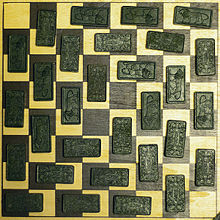
- Chess World Cup
- FIDE Grand Prix
- Olympiad
- World Championship
- List of strong tournaments
- List of world championships

- Checkmate patterns
- Chess openings
- Chess strategy
- Chess tactics
- Chess theory
- Endgames
- Pawn structure
- Problems/Compositions












| a | b | c | d | e | f | g | h | ||
| 8 |

  |
8 | |||||||
| 7 | 7 | ||||||||
| 6 | 6 | ||||||||
| 5 | 5 | ||||||||
| 4 | 4 | ||||||||
| 3 | 3 | ||||||||
| 2 | 2 | ||||||||
| 1 | 1 | ||||||||
| a | b | c | d | e | f | g | h | ||
The mutilated chessboard problem is a tiling puzzle proposed by philosopher Max Black in his book Critical Thinking (1946). It was later discussed by Solomon W. Golomb (1954), Gamow & Stern (1958) or by Martin Gardner in his Scientific American column "Mathematical Games." The problem is as follows:
Suppose a standard 8x8 chessboard has two diagonally opposite corners removed, leaving 62 squares. Is it possible to place 31 dominoes of size 2x1 so as to cover all of these squares?
Most considerations of this problem in literature provide solutions "in the conceptual sense" without proofs. John McCarthy proposed it as a hard problem for automated proof systems. In fact, its solution using the resolution system of inference is exponentially hard.
The puzzle is impossible to complete. A domino placed on the chessboard will always cover one white square and one black square. Therefore, a collection of dominoes placed on the board will cover an equal numbers of squares of each colour. If the two white corners are removed from the board then 30 white squares and 32 black squares remain to be covered by dominoes, so this is impossible. If the two black corners are removed instead, then 32 white squares and 30 black squares remain, so it is again impossible.
 Mutilated chessboard example showing like coloured empty squares (note the two empty black squares at the middle)
Mutilated chessboard example showing like coloured empty squares (note the two empty black squares at the middle)The same impossibility proof shows that no domino tiling exists whenever any two white squares are removed from the chessboard. However, if two squares of opposite colors are removed, then it is always possible to tile the remaining board with dominoes; this result is called Gomory's theorem, and is named after mathematician Ralph E. Gomory, whose proof was published in 1973. Gomory's theorem can be proven using a Hamiltonian cycle of the grid graph formed by the chessboard squares; the removal of two oppositely-colored squares splits this cycle into two paths with an even number of squares each, both of which are easy to partition into dominoes.